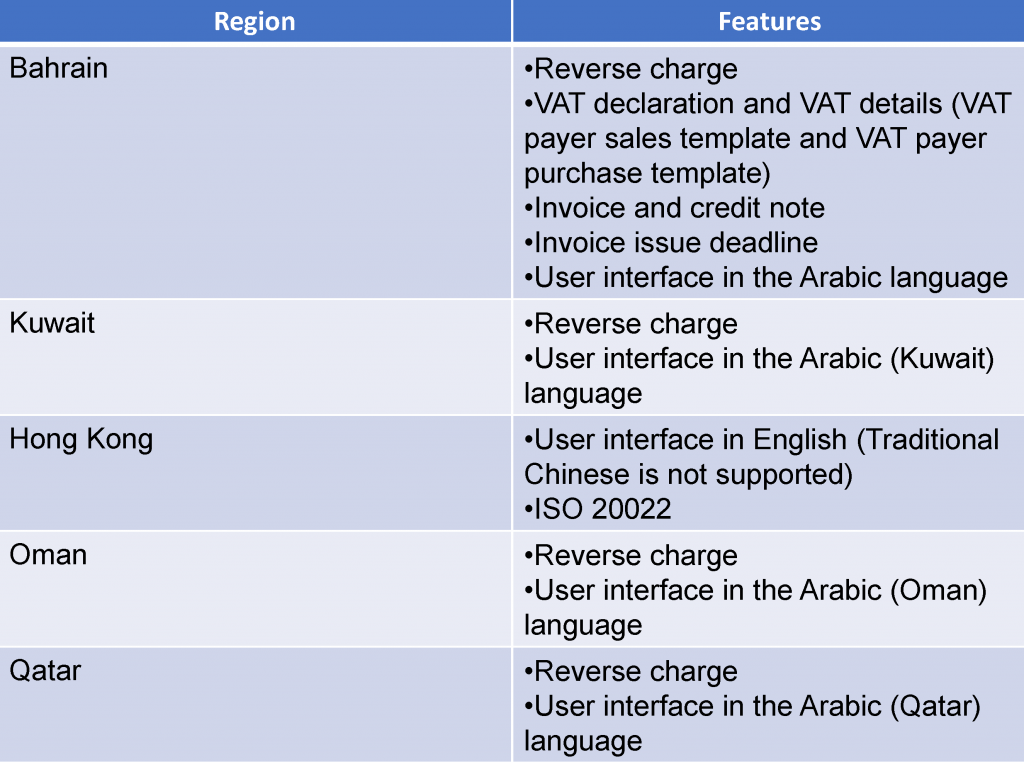MS team continues to complete the core functional capabilities of Dynamics 365 for Finance and Operations by automating and optimizing common processes to reduce the scope of manual work.
2020 release wave 2 will provide its users with new features from October 2020 through March 2021. Microsoft provides both online and offline versions of an upcoming release, including information related to Power Apps, Virtual Agents, Power Automate, and more.
Let’s have a look at what’s new and coming for D365 Finance and Operations.
Dynamics 365 Finance
The release provides updates for:
- Core Financials, automating common tasks to reduce the amount of manual work;
- Globalization, delivering localization for 5 additional regions – Oman, Hong Kong SAR, Bahrain, Kuwait, and Qatar. Eventually, the update expands regional coverage and simplifies configuration management;
- Public Sector – features related to the public sector industry.
Core Financials
The purpose of this is to reduce the time spent on manual work by automating common tasks, letting the system do the job, which was already mentioned above. So what exactly does it automate?
There are 16 new features, out of which 8 are about vendor invoice automation:
- Enhanced historical information – users can access invoice’s history information directly from the vendor invoice, omitting manual flow of clicks and searches to find the relevant information;
- Analytics – Power BI gives insights on what invoices didn’t make it through the process, boosting accountants and clerks to find and resolve the issue much faster.
- Three-way matching policy – this one matches quantities needed on vendor invoice lines to product receipts on the fly. Business value – labor costs are saved, as there is no need for employees to monitor the arrival of goods and manually match due to completion.
- Vendor Invoice Prevalidation – saves time and at the same time ensures the accuracy of the invoice before the one sent.
- Imported Vendor Invoice Submission to the Workflow – again, saves the time for users by avoiding the need to manually edit each invoice.
- Tracking – the feature illuminates errors by tracking both imported invoices and sales tax amounts. Users may now simply verify invoice totals before submitting them. It also tracks the date when an invoice was received.
- Multiple Invoices – lets users restart processing for multiple vendor invoices in a single step.
Other 8, on the other hand, do automation throughout other functions:
- Email Reminders – sends payment reminders to customers to encourage them to initiate payment sooner;
- Power BI – empowers financial workspace with enhanced analytical capabilities;
- Automatic Collection Task Creation;
- Asset leasing – the feature helps users to avoid offline lease calculations through automation;
- Cash Flow Forecast – not only this one helps to avoid manual calculation for cash flow forecast, but also schedules and monitors the process unless the job is done;
- Invoice Quantities – Product receipt Quantities | Match – provides with the flexibility to update both invoice and product receipt quantities to prevent posting invoices with errors;
- As well as Prepayment Notifications, Trial balance report, and more.
Keep in mind that public preview and general availability may differ so make sure to check with MS’s delivery timeline.
Globalization
Once again, MS team simplified configuration as well as expanded coverage over five additional regions, mainly Bahrain, Hong Kong SAR, Kuwait, Oman, and Qatar. The expansion delivers new features and capabilities for organizations – let’s have a look at them.
- Regulatory Configuration Service (RCS) simplification – lets organizations simplify, manage, and configure regulatory reports, e-invoices, payment formats, business documents, and tax rules at ease through a single service. The globalization feature helps to avoid multiple steps while handling, setting-up, and deploying globalization services by using one centralized bundle with all needed artifacts.
- Finvoice 3.0 – Finland users who utilize D365 for Finance / Supply Chain Management will be able to manage e-invoices to satisfy local (Finish) requirements.
- Advanced invoice notes management – simply allows organizations to have notes on products, vendors, customers, and documents.
- VAT directives on project invoices – as EU legislation demands that all member states shall follow rules on what information must be included when placing invoices, the feature supports tax directive text printing on both project and contract project invoices which previously was available only for eastern EU member countries.
- RCS – Global repository simplification – users will be allowed to configure such red tape work as invoices, documents, tax rules and regulatory reports which are altered by changing legal stipulations. Eventually, users will be able to control, store/publish/share configurations directly in RCS omitting LS (Lifecycle Services) through the entire organization.
- Documents PDF conversion – simply provides customers and partners with an ability to convert Excel and Word documents into PDF format for easy document exchange within a product.
- Documents direct printing – the feature optimizes document flow for customers letting them print orders and invoices in an instant from the system, whether it’s a single document or there is a queue of them.
- Electronic reporting – Legal entity – electronic reporting framework (ER) improvements simplify and enhance legislatively required reports flow with customizations to make required legislative changes to reports more efficiently.
- Unit price and cost price handling in stock transfer orders for India – stock transfer order advances both unit price and cost price handling to comply with local tax regulations.
- Region expansion: Bahrain, Hong Kong, Kuwait, Oman, Qatar – as globalization extended D365 Finance coverage through these regions, even though features may vary, they are pretty much the same except for Bahrain and Hong Kong.

Public Sector
- Multiple purchasing work items delegation – purchase requisitions, agreements, orders and invoices now can be delegated work items through a single action, rather than one at a time as it used to be.
- 1099: default value association to Main account – improves reporting accuracy and compliance through 1099 box number association with a main account.
- Accounting distribution: vendor invoice edits restriction – such prohibition helps to lock values for certain accounts (e.g. fund account), preserving accounting information correctness and reliability, while letting users to change the main account.
Dynamics 365 Supply Chain Management
We also would like to introduce new features for D365 Supply Chain Management which are planned to be released from October 2020 through March 2021. The ones aim to enhance and improve inventory management, costing, manufacturing, planning, product information, trade and source, and warehouse and transportation management modules.
Let’s delve and analyze what to expect from the release wave 2.
Costing
- Cost allocation – the feature will provide partners with insights on profitability of products/group of products through cost allocation using more than one allocation basis.
Manufacturing
- Number registration entrance – lets job card users enter serial number while reporting as finished. In the end, it supports manual serial numbers (both pre-allocated and fixed) registration.
- Production floor execution – improves management and recording of production activities through updated UX interface as well as a new feature, letting workers operate multiple jobs at the same time.
Inventory management
- Enterprise-scale inventory – improved performance while dealing with inventory information and enhanced with new ability to archive inventory transactions.
Planning
- Planning optimization – MS team is planning to launch several functional enhancements with wave 2 release to boost planning optimization, mainly intercompany planning, purchase requisitions, forecast sub-models, time margins, purchase requisitions and time margins.
- Planning optimization support – with the release, Material Requirements Planning (MRP) will be improved to deliver better experience for planners while providing almost real-time planning. It’s crucial to know for planners whether materials are available and/or are ready for customer delivery at manufacturing companies.
Product information management
- New inventory dimensions – among color, size and style product dimensions there is going to be another one – version, which is created to assist users with tracking multiple product versions throughout the supply chain.
There are also two new product dimensions which increase the total number of dimensions from 10 to 12, which aims to give more flexibility – meet InventDimension11 and InventDimension12.
Trade and Source
- Vendor RFQ: search bar – we’ve got an updated interface with an ability to use a search bar which makes life easier for vendors to find relevant RFQs. Make sure public sector features are switched on, otherwise you won’t be able to use this one.
- Vendor RFQ: default reply fields – This feature allows you to specify specific types of information you’d like to get from vendors once they reply/bid on a request for RFQ. Those fields are marked as default and will be included on both online form from the provided vendor and printed on RFQ reply sheets sent to vendors.
- Vendor RFQs: preserved bid data – even if an RFQ was adjusted by a buyer, the feature helps vendors to submit bits for relevant items which eventually saves time and helps to avoid data reentering.
- Vendor-submitted Bank details – this one allows vendors to include bank account related information for their vendor record through collaboration interface. The process has an approval process, whereas submission may be only included if approved by a relevant person in an organization.
- Vendor-submitted certifications – almost the same as the previous one, lets vendors to submit certifications, through collaboration interface, for storage and reference.
- Inbound transportation management – shippers in different industries now can use benefits through landed cost and inbound transportation management system supercharging its supply chain execution. Improved accuracy for costing, cut costing errors, better item cost decision and many more.
- Procurement categories approval – provides users with an ability to request collaboration with a new procurement category. There is also a workflow to help buyers review each request and prevent approval/initialization of undesirable collaborations.
Warehouse and transportation management
- Outbound Shipments – there is a new ability for users to automatically confirm and initiate batch outbound for ready-to-ship loads. Furthermore, transfer order shipments will be updated automatically for load lines related to transfer orders.
- Work pick line – quite useful for those organizations which are in the warehouse industry. It helps to define lines for current work so workers could decide which one to pick next. In other words – that is work sequence optimization.
- Work policy improvement – there is a new update for inbound work where clerks receive better process experience. Now, they can omit creating warehouse when receiving goods registering inbound physical inventory straight to the inbound receiving dock.
- Transfer orders – aims to optimize warehouse workflow by implementing new functionality, letting users create, manage, and process transfer orders straight from the warehouse app.
Furthermore, MS team has also added a queue for event processing to the app. Batch jobs can pull data from this queue to react to the signaled events.
Let’s Sum Up
Both Dynamics 365 for Finance and Supply Chain Management updates are aiming to improve optimization so organizations would spend less on operations, which eventually cut costs drastically. At least, that’s the plan and we will see once features are being used at least 2-3 mo by users.
And, of course, in case you, dear reader, have a struggle implementing these ones – don’t hesitate to reach out so would could give you a helping hand!



